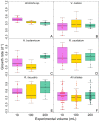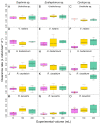Container volume may affect growth rates of ciliates and clearance rates of their microcrustacean predators in microcosm experiments
- PMID: 33814976
- PMCID: PMC8009685
- DOI: 10.1093/plankt/fbab017
Container volume may affect growth rates of ciliates and clearance rates of their microcrustacean predators in microcosm experiments
Abstract
We studied the effect of volume in small containers (microcosms) on five common planktonic freshwater ciliates and three zooplankton species, namely Daphnia sp., the calanoid copepod Eudiaptomus sp., and the cyclopoid copepod Cyclops sp. We measured ciliate specific growth rates and their loss rates due to microcrustacean predation in short-term experiments. We hypothesized that container volume ranging from 10 to 200 mL would not affect the activity of our prey and predator species. We found that the response to volume was species-specific; growth rates of three ciliate species were sensitive to volume. However, the volume effect was not unequivocal because different timing of the microcosm experiments (block effects) may have caused random bias due to varying morphological and/or physiological conditions of the ciliates and their predators. For predator clearance rate, the volume effect was insignificant in the filter-feeding Daphnia and Eudiaptomus but was significant for the predatory copepod Cyclops, which was hampered in the smallest experimental containers. Total crustacean clearance rates averaged over all treatments appeared unaffected by predator species, while ciliate species significantly affected the results. Our growth and clearance rates are close to previous findings with the same or similar planktonic prey and predator species.
Keywords: Cyclops; Daphnia; Eudiaptomus; ciliates; growth and clearance rates; volume effect.
© The Author(s) 2021. Published by Oxford University Press.
Figures



Similar articles
-
Top-down control of planktonic ciliates by microcrustacean predators is stronger in lakes than in the ocean.Sci Rep. 2022 Jun 22;12(1):10501. doi: 10.1038/s41598-022-14301-y. Sci Rep. 2022. PMID: 35732678 Free PMC article.
-
Predation on the Invasive Copepod, Pseudodiaptomus forbesi, and Native Zooplankton in the Lower Columbia River: An Experimental Approach to Quantify Differences in Prey-Specific Feeding Rates.PLoS One. 2015 Nov 30;10(11):e0144095. doi: 10.1371/journal.pone.0144095. eCollection 2015. PLoS One. 2015. PMID: 26618851 Free PMC article.
-
Ciliate epibionts associated with crustacean zooplankton in german lakes: distribution, motility, and bacterivory.Front Microbiol. 2012 Jul 5;3:243. doi: 10.3389/fmicb.2012.00243. eCollection 2012. Front Microbiol. 2012. PMID: 22783247 Free PMC article.
-
Birds of prey as limiting factors of gamebird populations in Europe: a review.Biol Rev Camb Philos Soc. 2005 May;80(2):171-203. doi: 10.1017/s146479310400658x. Biol Rev Camb Philos Soc. 2005. PMID: 15921048 Review.
-
The influence of intraguild predation on prey suppression and prey release: a meta-analysis.Ecology. 2007 Nov;88(11):2689-96. doi: 10.1890/06-1869.1. Ecology. 2007. PMID: 18051635 Review.
Cited by
-
Numerical and functional response of phagotrophic aquatic protists: the ideal experiment-and why we cannot get it.Front Microbiol. 2025 Jun 10;16:1559802. doi: 10.3389/fmicb.2025.1559802. eCollection 2025. Front Microbiol. 2025. PMID: 40556895 Free PMC article.
-
Top-down control of planktonic ciliates by microcrustacean predators is stronger in lakes than in the ocean.Sci Rep. 2022 Jun 22;12(1):10501. doi: 10.1038/s41598-022-14301-y. Sci Rep. 2022. PMID: 35732678 Free PMC article.
References
-
- Adrian, R. and Schneider-Olt, B. (1999) Top-down effects of crustacean zooplankton on pelagic microorganisms in a mesotrophic lake. J. Plankton Res., 21, 2175–2190.
-
- Agasild, H., Zingel, P. and Nõges, T. (2012) Live labeling technique reveals contrasting role of crustacean predation on microbial loop in two large shallow lakes. Hydrobiologia, 684, 177–187.
-
- Altermatt, F., Fronhofer, E. A., Garnier, A., Giometto, A., Hammes, F., Klecka, J., Legrand, D., Mächler, E. et al. (2015) Big answers from small worlds: a user's guide for protist microcosms as a model system in ecology and evolution. Methods Ecol. Evol., 6, 218–231.
-
- Armengol, L., Franchy, G., Ojeda, A., Santana-del Pino, Á. and Hernández-León, S. (2017) Effects of copepods on natural microplankton communities: do they exert top-down control? Marine Biol., 164, 136.
-
- Bergkemper, V. and Weisse, T. (2017) Phytoplankton response to the summer heat wave 2015 – a case study from Lake Mondsee, Austria. Inland Waters, 7, 88–99.
LinkOut - more resources
Full Text Sources
Other Literature Sources

